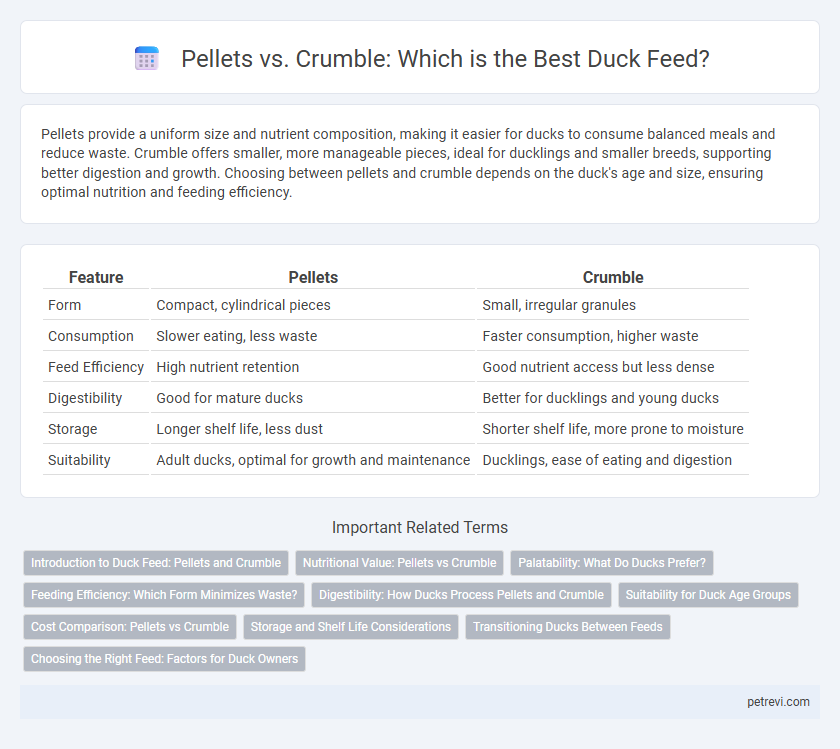Pellets provide a uniform size and nutrient composition, making it easier for ducks to consume balanced meals and reduce waste. Crumble offers smaller, more manageable pieces, ideal for ducklings and smaller breeds, supporting better digestion and growth. Choosing between pellets and crumble depends on the duck's age and size, ensuring optimal nutrition and feeding efficiency.
Table of Comparison
| Feature | Pellets | Crumble |
|---|---|---|
| Form | Compact, cylindrical pieces | Small, irregular granules |
| Consumption | Slower eating, less waste | Faster consumption, higher waste |
| Feed Efficiency | High nutrient retention | Good nutrient access but less dense |
| Digestibility | Good for mature ducks | Better for ducklings and young ducks |
| Storage | Longer shelf life, less dust | Shorter shelf life, more prone to moisture |
| Suitability | Adult ducks, optimal for growth and maintenance | Ducklings, ease of eating and digestion |
Introduction to Duck Feed: Pellets and Crumble
Duck feed comes primarily in two forms: pellets and crumble, each designed to meet specific nutritional needs and feeding habits of ducks. Pellets offer a uniform, dense shape that reduces waste and ensures consistent nutrient intake, while crumble provides a smaller, crumbly texture ideal for young or smaller ducks to consume easily. Choosing between pellets and crumble depends on the age, size, and feeding behavior of the ducks to optimize growth and health.
Nutritional Value: Pellets vs Crumble
Pellets provide a consistent nutritional profile with balanced proteins, vitamins, and minerals essential for duck health, supporting optimal growth and immune function. Crumble feed offers greater digestibility due to its smaller particle size, enhancing nutrient absorption and reducing waste compared to pellets. Both forms ensure nutrient density, but crumble may improve feed efficiency in young ducks or those with sensitive digestion.
Palatability: What Do Ducks Prefer?
Ducks generally prefer pellets over crumble due to the uniform shape and size of pellets, which makes them easier to grasp and consume. Pellets maintain consistent texture and flavor, enhancing palatability and reducing selective feeding compared to crumble, which can separate and lose nutrient balance. Studies indicate improved feed intake and growth rates in ducks fed pellets, highlighting their preference for this feed form.
Feeding Efficiency: Which Form Minimizes Waste?
Pellets generally offer higher feeding efficiency for ducks by maintaining structural integrity, reducing feed wastage caused by scattering or selective feeding. Crumbles tend to break apart more easily, leading to increased feed loss as ducks often spill or sift through them. Studies show pellet feed can minimize waste by up to 15% compared to crumble form, improving overall feed utilization and cost-effectiveness.
Digestibility: How Ducks Process Pellets and Crumble
Ducks digest pellets and crumble feed differently due to their texture and density. Pellets are denser, promoting slower consumption and enhanced nutrient absorption, while crumble feed breaks down more rapidly, allowing quicker digestion and intake. Optimal digestibility depends on the duck's age and feeding behavior, with pellets favoring mature ducks and crumble suiting ducklings.
Suitability for Duck Age Groups
Pellets offer a consistent size and density ideal for adult ducks, promoting steady growth and minimizing feed wastage. Crumble, with its smaller particles and softer texture, suits ducklings and young ducks by facilitating easier consumption and digestion during early developmental stages. Matching feed form to duck age maximizes nutrient absorption and supports optimal health throughout growth phases.
Cost Comparison: Pellets vs Crumble
Pellet feed for ducks generally costs more upfront due to the processing involved but offers better storage stability and less waste compared to crumble feed. Crumble feed tends to be less expensive initially and can be more suitable for young ducks or those with smaller beaks, though it may result in higher feed spillage and wastage. Evaluating the cost-effectiveness between pellets and crumbles requires considering feed efficiency, wastage rates, and the specific nutritional needs of the duck flock.
Storage and Shelf Life Considerations
Pellets for duck feed typically offer longer shelf life due to their compressed form, reducing moisture absorption and spoilage risk. Crumble feed, being more fragmented, is more susceptible to humidity and pests, requiring sealed storage containers to maintain freshness. Proper storage of pellets in cool, dry environments can extend usability, making them more practical for long-term feeding compared to crumble.
Transitioning Ducks Between Feeds
Transitioning ducks from pellets to crumble feed requires gradual mixing to prevent digestive issues and ensure nutrient intake remains consistent. Ducks more readily accept crumble feed during molting or growth phases, as its texture promotes easier consumption and digestion compared to pellets. Properly balancing protein, vitamins, and minerals in the new feed prevents nutritional deficiencies and supports healthy development throughout the transition period.
Choosing the Right Feed: Factors for Duck Owners
Pellets offer uniform nutrient distribution and reduce feed wastage, making them ideal for ducks as they promote consistent growth and health. Crumble feed, being smaller and easier to digest, is especially beneficial for ducklings and young ducks requiring higher energy for development. Duck owners should consider factors such as the age of the ducks, feeding behavior, and nutritional needs when choosing between pellets and crumble to optimize health and productivity.
Pellets vs Crumble for Duck feed Infographic

 petrevi.com
petrevi.com